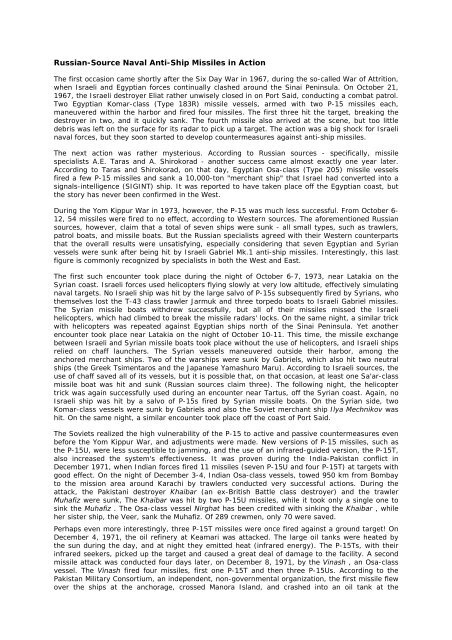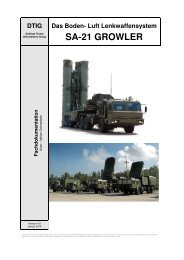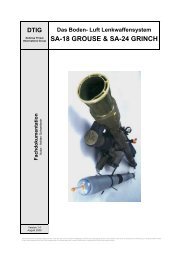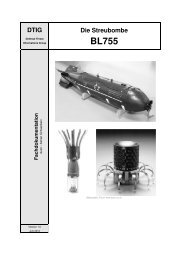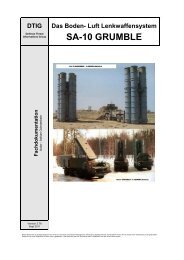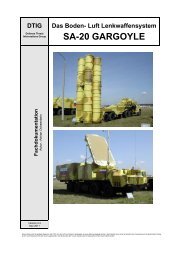RUSSIAN/SOVIET SEA-BASED ANTI-SHIP MISSILES Specia ... - DTIG
RUSSIAN/SOVIET SEA-BASED ANTI-SHIP MISSILES Specia ... - DTIG
RUSSIAN/SOVIET SEA-BASED ANTI-SHIP MISSILES Specia ... - DTIG
You also want an ePaper? Increase the reach of your titles
YUMPU automatically turns print PDFs into web optimized ePapers that Google loves.
Russian-Source Naval Anti-Ship Missiles in Action<br />
The first occasion came shortly after the Six Day War in 1967, during the so-called War of Attrition,<br />
when Israeli and Egyptian forces continually clashed around the Sinai Peninsula. On October 21,<br />
1967, the Israeli destroyer Eliat rather unwisely closed in on Port Said, conducting a combat patrol.<br />
Two Egyptian Komar-class (Type 183R) missile vessels, armed with two P-15 missiles each,<br />
maneuvered within the harbor and fired four missiles. The first three hit the target, breaking the<br />
destroyer in two, and it quickly sank. The fourth missile also arrived at the scene, but too little<br />
debris was left on the surface for its radar to pick up a target. The action was a big shock for Israeli<br />
naval forces, but they soon started to develop countermeasures against anti-ship missiles.<br />
The next action was rather mysterious. According to Russian sources - specifically, missile<br />
specialists A.E. Taras and A. Shirokorad - another success came almost exactly one year later.<br />
According to Taras and Shirokorad, on that day, Egyptian Osa-class (Type 205) missile vessels<br />
fired a few P-15 missiles and sank a 10,000-ton "merchant ship" that Israel had converted into a<br />
signals-intelligence (SIGINT) ship. It was reported to have taken place off the Egyptian coast, but<br />
the story has never been confirmed in the West.<br />
During the Yom Kippur War in 1973, however, the P-15 was much less successful. From October 6-<br />
12, 54 missiles were fired to no effect, according to Western sources. The aforementioned Russian<br />
sources, however, claim that a total of seven ships were sunk - all small types, such as trawlers,<br />
patrol boats, and missile boats. But the Russian specialists agreed with their Western counterparts<br />
that the overall results were unsatisfying, especially considering that seven Egyptian and Syrian<br />
vessels were sunk after being hit by Israeli Gabriel Mk.1 anti-ship missiles. Interestingly, this last<br />
figure is commonly recognized by specialists in both the West and East.<br />
The first such encounter took place during the night of October 6-7, 1973, near Latakia on the<br />
Syrian coast. Israeli forces used helicopters flying slowly at very low altitude, effectively simulating<br />
naval targets. No Israeli ship was hit by the large salvo of P-15s subsequently fired by Syrians, who<br />
themselves lost the T-43 class trawler Jarmuk and three torpedo boats to Israeli Gabriel missiles.<br />
The Syrian missile boats withdrew successfully, but all of their missiles missed the Israeli<br />
helicopters, which had climbed to break the missile radars' locks. On the same night, a similar trick<br />
with helicopters was repeated against Egyptian ships north of the Sinai Peninsula. Yet another<br />
encounter took place near Latakia on the night of October 10-11. This time, the missile exchange<br />
between Israeli and Syrian missile boats took place without the use of helicopters, and Israeli ships<br />
relied on chaff launchers. The Syrian vessels maneuvered outside their harbor, among the<br />
anchored merchant ships. Two of the warships were sunk by Gabriels, which also hit two neutral<br />
ships (the Greek Tsimentaros and the Japanese Yamashuro Maru). According to Israeli sources, the<br />
use of chaff saved all of its vessels, but it is possible that, on that occasion, at least one Sa'ar-class<br />
missile boat was hit and sunk (Russian sources claim three). The following night, the helicopter<br />
trick was again successfully used during an encounter near Tartus, off the Syrian coast. Again, no<br />
Israeli ship was hit by a salvo of P-15s fired by Syrian missile boats. On the Syrian side, two<br />
Komar-class vessels were sunk by Gabriels and also the Soviet merchant ship Ilya Mechnikov was<br />
hit. On the same night, a similar encounter took place off the coast of Port Said.<br />
The Soviets realized the high vulnerability of the P-15 to active and passive countermeasures even<br />
before the Yom Kippur War, and adjustments were made. New versions of P-15 missiles, such as<br />
the P-15U, were less susceptible to jamming, and the use of an infrared-guided version, the P-15T,<br />
also increased the system's effectiveness. It was proven during the India-Pakistan conflict in<br />
December 1971, when Indian forces fired 11 missiles (seven P-15U and four P-15T) at targets with<br />
good effect. On the night of December 3-4, Indian Osa-class vessels, towed 950 km from Bombay<br />
to the mission area around Karachi by trawlers conducted very successful actions. During the<br />
attack, the Pakistani destroyer Khaibar (an ex-British Battle class destroyer) and the trawler<br />
Muhafiz were sunk, The Khaibar was hit by two P-15U missiles, while it took only a single one to<br />
sink the Muhafiz . The Osa-class vessel Nirghat has been credited with sinking the Khaibar , while<br />
her sister ship, the Veer, sank the Muhafiz. Of 289 crewmen, only 70 were saved.<br />
Perhaps even more interestingly, three P-15T missiles were once fired against a ground target! On<br />
December 4, 1971, the oil refinery at Keamari was attacked. The large oil tanks were heated by<br />
the sun during the day, and at night they emitted heat (infrared energy). The P-15Ts, with their<br />
infrared seekers, picked up the target and caused a great deal of damage to the facility. A second<br />
missile attack was conducted four days later, on December 8, 1971, by the Vinash , an Osa-class<br />
vessel. The Vinash fired four missiles, first one P-15T and then three P-15Us. According to the<br />
Pakistan Military Consortium, an independent, non-governmental organization, the first missile flew<br />
over the ships at the anchorage, crossed Manora Island, and crashed into an oil tank at the


